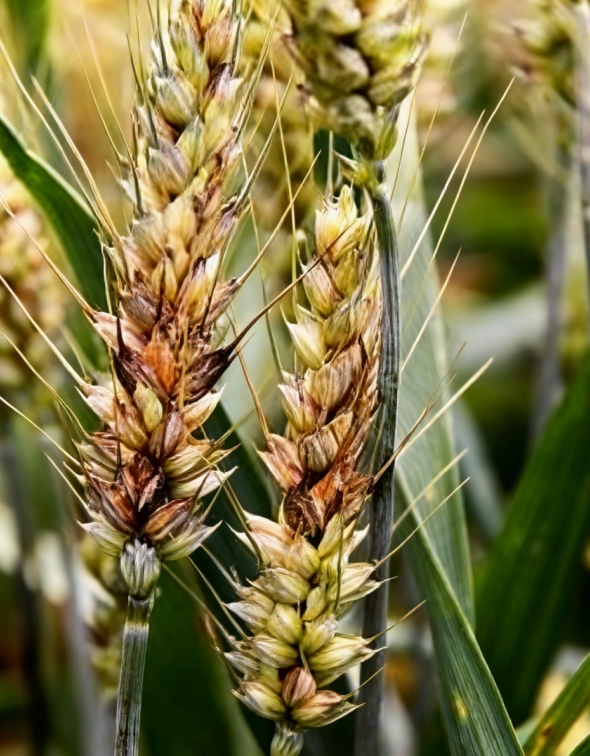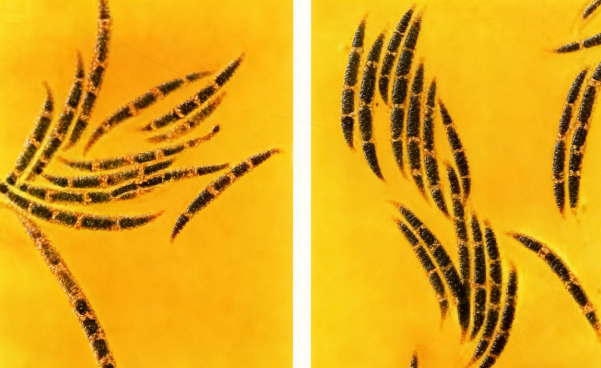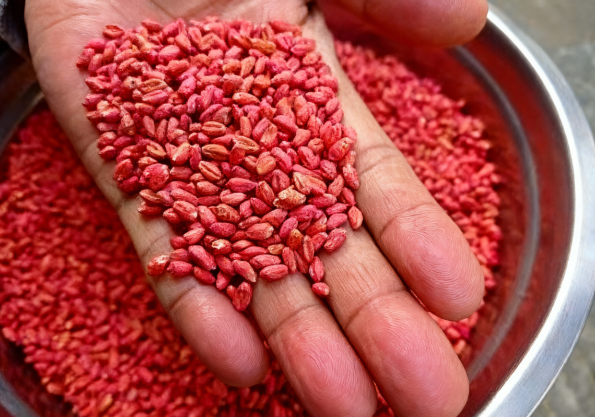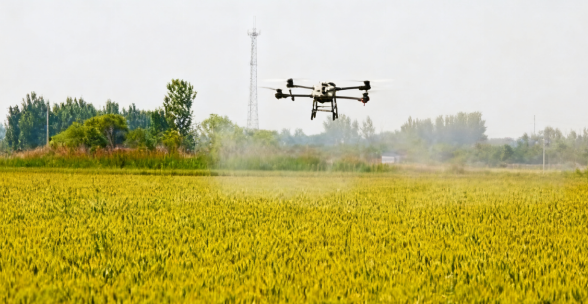Wheat Scab
Wheat Scab
1. Introduction
1.1. Wheat fusarium head blight is a disease that occurs on wheat and is caused by infection with a variety of Fusarium fungi. It can occur from the seedling stage to the ear stage, causing seedling rot, stem base rot, stalk rot and ear rot, among which ear rot is the most harmful.

When the humidity is high, a pink mold layer can be seen on the diseased part.
1.2. Disease damage
(1)After wheat is infected, the thousand-grain weight decreases, the germination rate decreases, the germination potential weakens, the flour yield is low, the flour quality is poor, the color is gray, and the commercial value is reduced.
(2)Diseased wheat contains toxins such as vomiting toxins and estrogen-like toxins, which can cause acute poisoning after being eaten by humans and animals. Diseased wheat grains contain toxins such as deoxynivalenol and zearalenone, which can also cause pregnant female animals to miscarry after poisoning.
1.3. Disease occurrence pattern
It is particularly serious in rainy and humid temperate zones. In general, the diseased ear rate in epidemic years is 50-100%, with a yield loss of 10-20%, and in moderate years, the diseased ear rate is 30-50%, with a yield loss of 5-10%.
1.4. Pathogens
(1)Caused by various Fusarium species, such as Fusarium graminearum schw., Fusarium avenaceum (Fr.) Sacc., Fusarium moniliforme sheld., Fusarium culmorum (W. G. Smith) Sacc., and Fusarium acuminatum (ElL et Ev) Wr.
(2)The most common of these are: Fusarium graminearum schw.

Its conidia are sickle-shaped, with 3-7 septa, obtuse apex, obvious foot cells at the base, and individual spores are colorless, while aggregated spores appear pink and viscous.
2. Symptoms
2.1. Symptoms at different growth stages
(1)Seedling rot: caused by infection of seeds with bacteria or pathogens in the soil. First, the buds turn brown, and then the root crown rots. In mild cases, the diseased seedlings are yellow and thin, and in severe cases, the seedlings die. It is easy to pull the diseased plants by hand from the rotten part, and the broken end is brown with sticky rotten tissue.
(2)Stem base rot: It can occur from the emergence of seedlings to maturity. The base tissue of the wheat plant turns brown and rots after being infected, causing the whole plant to die.
(3)Stalk rot: It often occurs in the first and second nodes under the ear. At first, water-soaked chlorotic spots appear on the leaf sheath, and then expand into light brown to reddish brown irregular spots. The spots can also expand into the stem. When the disease is serious, it causes the diseased part to wither and turn yellow, and sometimes it is impossible to ear or pull out withered and yellow ears.
(4)Ear rot: In the early stage of occurrence, small water-soaked light brown spots appear on the spikelets and glumes, and then gradually expand to the entire spikelet, and the spikelets wither and turn yellow. When the humidity is high, a pink gelatinous mold layer is produced at the lesions. In the later stage, small black spots are densely grown on it, which are the ascocarps. Later it spreads to the ear axis, the diseased part turns dry and brown, and the spikelets above the affected part turn into dry and white ears.
3. Prevention and treatment plan
3.1 Agricultural prevention and control.
Rationally manage fertilizers and water, clear ditches and drain water in time, reduce field humidity, and reduce the incidence of diseases.
3.2. Seed dressing with chemicals

Recommended formula:
Difenoconazole 2.4%+Fludioxonil 2.4% FS
Thiram 21%+Triadimenol 3% FS
3.3. Chemical spray control
(1) Control at the appropriate time. According to the disease occurrence patterns of previous years, the first control (spraying when flowers appear) is generally carried out from the time when wheat ears are fully grown to the early stage of flowering. Depending on the severity of the disease, another control can be carried out 5-7 days later. For areas where the disease has occurred seriously for consecutive years, and the weather conditions are often rainy, condensed, and foggy, the first application of pesticides should be advanced to the heading stage. If it is rainy during the flowering period of wheat, choose to apply pesticides during the interval after rain or before the rain. If it rains within 3-6 hours after applying the pesticides, it should be promptly treated after the rain to ensure the prevention effect.
(2)Recommended drugs: prothioconazole, pydiflumetofen , phenamacril+tebuconazole, propaconazole+tebuconazole, cyproconazole+tebuconazole, phenamacril+hexaconazole and other high-quality drugs with good prevention effect on ergot and strong toxin control can be used. At the same time, they can also treat wheat rust, powdery mildew and other ear diseases. It is recommended to use high-value and effective products for the first use of drugs, and use drugs with different mechanisms of action alternately for the second time. In areas with high resistance to benzimidazole drugs, drugs such as carbendazim and methyl thiophanate should be used with caution, and rotation and combination of drugs are recommended.
(3)Modern medical equipment
It is recommended to use modern and efficient plant protection machinery such as plant protection drones and self-propelled boom sprayers to carry out integrated prevention and control of wheat scab, and achieve an integrated prevention and control coverage rate of more than 80%. However, it is necessary to standardize the plant protection drone control operation standards and implement the technical parameters of plant protection drone control of wheat scab (water consumption per mu is 0.8L-1.5L, flight altitude is 1.8m-2.2m above the wheat canopy, and flight speed is less than 6m/s; new models can be adjusted appropriately, and the droplet coverage density of the crop canopy must be ensured to be no less than 15).

3.4.Other aspects: Manage storage and prevent infection.
Given that wheat grains infected with ergot can continue to be infected under humid conditions, leading to a further increase in fungal toxins, all regions should strengthen wheat storage management, harvest in time, dry, eliminate ergot kernels, and store below safe humidity.
Other information

